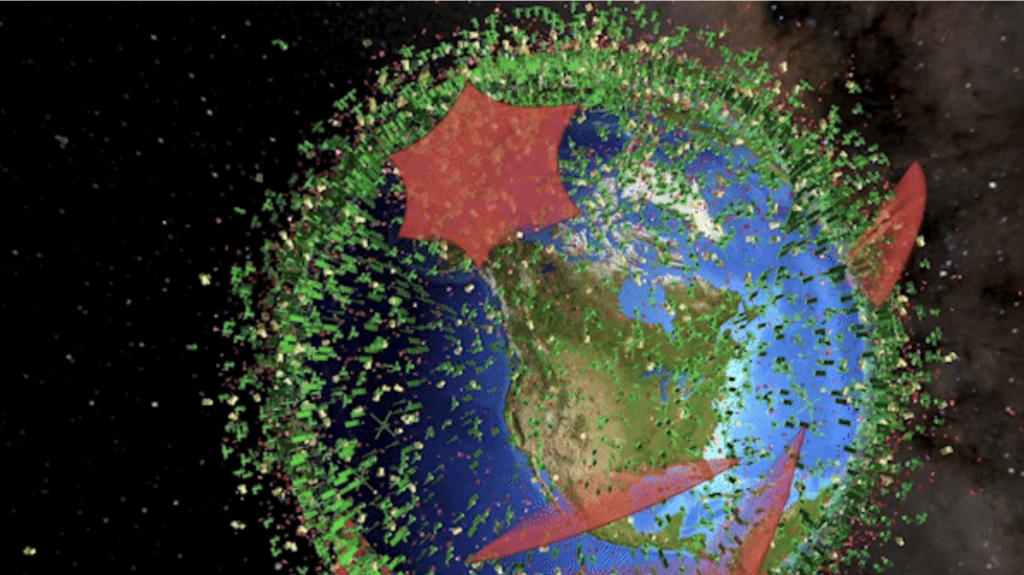
A new LeoLabs’ software tool allows insurers to visualize collision risks to client satellites. (Image: LeoLabs)
NEW YORK — A trio of satellite breakups — two caused by anti-satellite (ASAT) missile tests — are responsible for a large percentage of dangerous debris in the ever-more popular real estate of low Earth orbit, creating an especially “bad neighborhood” there, according to space traffic observers at LeoLabs.
“This is why ASAT tests are bad,” Rachit Bhatia, LeoLabs’ space safety analytics & research lead, told the Secure World Foundation’s 5th Summit for Space Sustainability on Wednesday.
Data from the company, which uses a radar constellation and sophisticated software to track objects and LEO and predict the likelihood of dangerous collisions, highlights the increased risks to operators caused by: the destruction of China’s Fengyun-1C satellite in a 2007 ASAT missile test; Russia’s similar destruction of the Cosmos 1408 in 2021; and the non-deliberate collision of Cosmos 2251 with an Iridium satellite in 2009.
Together, these three on-orbit breakups account for 15 percent of debris cataloged in all near-Earth orbits since the US military started keeping tabs in the late 1950s, Bhatia said. US Space Command, which currently is responsible for monitoring the heavens, is tracking some 41,000 pieces of space junk bigger than 10 centimeters, Gen. James Dickinson said in February.
Further, the space junk pile up has created what Bhatia called a “bad neighborhood” in the 700 to 900 kilometer band of LEO, a region that is increasingly crowded due to advent of mega-constellations such as SpaceX’s Starlink communications satellites. That orbital altitude also is being used by the Space Development Agency for its planned Transport Layer of 300 to 500 high-speed, high-volume communications birds.
A number of US government and military officials speaking at the Secure World event here did so to double down on Washington’s push for a voluntary ban on testing of destructive ASAT missiles in the run up to the final meeting of the UN Open Ended Working Group (OEWG) on Reducing Space Threats, that runs Aug. 28-Sept. 1. That working group is attempting, for the first time, to reach agreement on a set of norms that would constrain military actions in space to try to keep the peace in space.
For example, Eric Desautels, deputy assistant secretary of arms control, verification and compliance at the State Department, also wheeled out some scary data on the dangers caused by ASAT-created space junk during his keynote Wednesday at the summit.
The Russian and Chinese tests are responsible for “pretty much 20 percent” of “conjunction” warnings, that is predictions that two space objects are likely to collide, in 2022, he said.
Desautels said that Space Command data shows that there were 1,486 conjunctions involving the International Space Station in 2022, “which was a 233 percent increase from 2021. And that increase was largely conducted because of the debris from the anti-satellite missile tests, and also required us to maneuver the International Space Station two times last year.”
Further, he said, “that debris is going to reduce the life of satellites because they’re using fuel to maneuver. It’s going to increase the cost to companies and to governments. … That is something obviously we want to avoid.”
The White House body for coordinating science policy, the National Science and Technology Council, in late March put the State and Defense departments in charge of “prioritizing sustainable access” to LEO — as part of a new interagency strategy for supporting government-wide research activities in the lowest band of space, from about 2,000 kilometers in altitude down to about 100 kilometers.
The US government also is pushing a voluntary moratorium on destructive ASAT missile tests, putting forward a UN General Assembly resolution calling on states to individually commit that passed in December with 155 of the UN’s 193 member states voting yes.
Desautel noted that there were nine “no” votes on the resolution: “Russia and China and then their close allies, [including] Cuba, Iran, Syria, Nigeria.”
However, as the National Security Council’s director of space policy, Audrey Schaffer, pointed out in a keynote to the Secure World summit on Tuesday, the resolution does not represent a binding promise on signatories.
“It doesn’t commit states to the norm. It encourages states to make national commitments to this norm,” she said. “To truly establish an internationally recognized norm banning destructive DA-ASAT [direct-assent ASAT] missile testing, we need a critical mass of nations to actually make the commitment.”
Up to now, 13 nations have joined the US in formally pledging themselves to the testing moratorium.
Lt. Gen. John Shaw, SPACECOM deputy commander, told the Secure World Summit on Wednesday that the Pentagon also strongly backs the idead because it is the military’s interest.
“DoD was one of the biggest, earliest proponents of the test moratorium,” he said.
In addition, the US government is pushing states to commit to the testing ban at the OEWG.
Desautel reiterated that the US government has put forward seven norms for consideration at the OEWG, and is hoping others will support them. This includes, he noted, one that would take the ASAT testing moratorium “a step further” by calling on countries to “consider refraining from all experiments or activities that could result in the creation of debris, including the intentional creation of debris.”
While government officials and experts involved in the OEWG say the meeting faces and uphill challenge in getting a truculent Moscow to approve of any new norms, there is a sense of optimism that things are going in the right direction.
One idea that may well win out during the final OEWG meeting is the idea to have a follow-on series of OEWG meetings to build on the ideas with a lot of support, these sources said, such as the need for states to act with “due regard” for others in space and improved consultative measures.
“And that’s not a bad thing,” Secure World’s Victoria Samson told Breaking Defense.






















